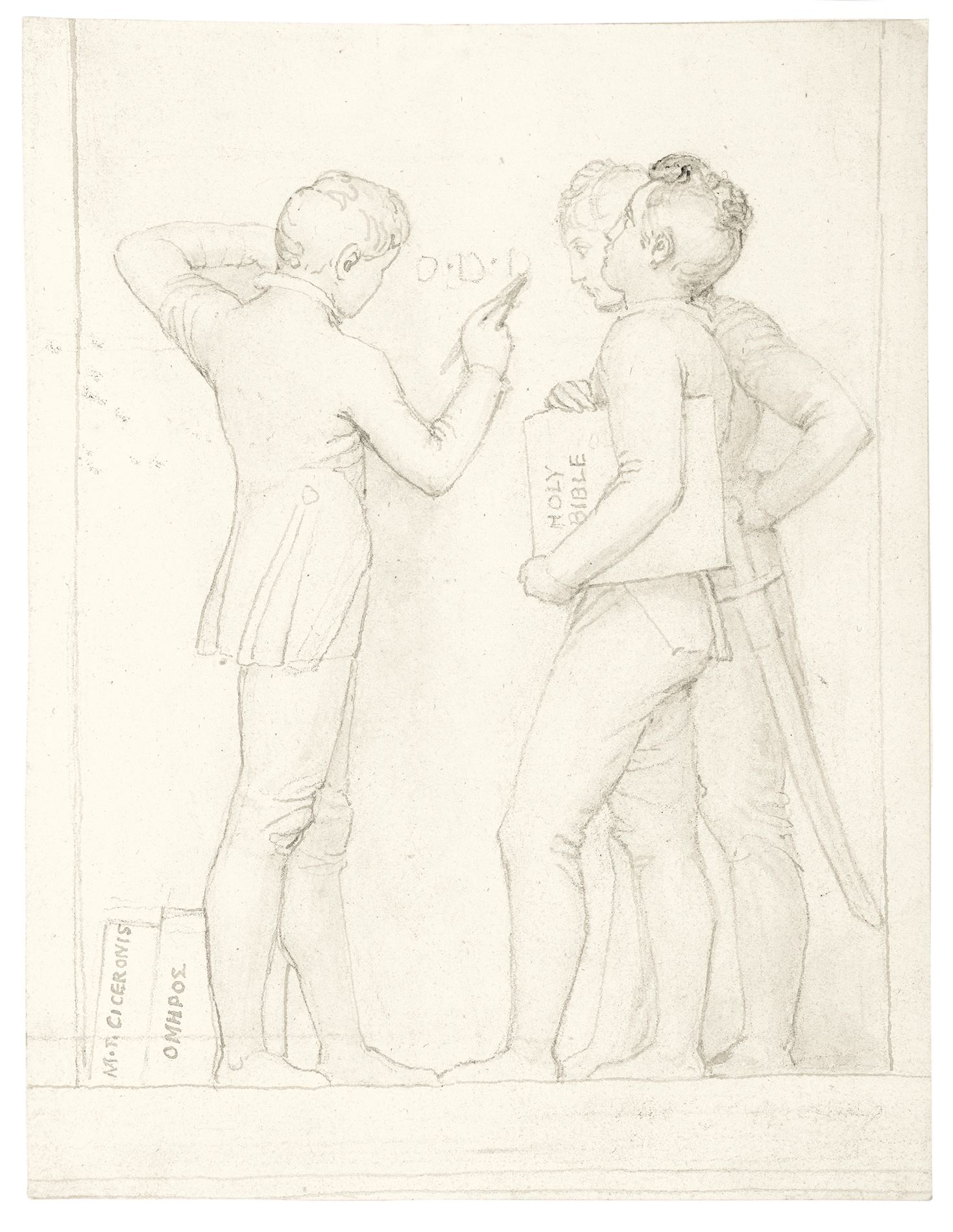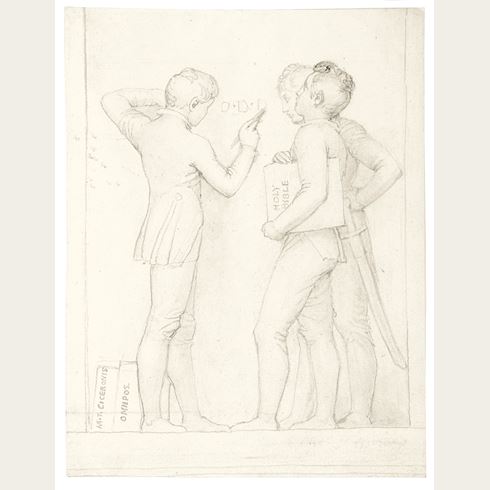John FLAXMAN
(York 1755 - London 1826)
Three Youths Inscribing a Wall: Design for a Monument to John Lyon, Founder of Harrow School
Sold
Pencil, pen and brown ink and pale brown wash, with framing lines in pencil.
Faintly and indistinctly inscribed in pencil at the lower right.
Inscribed John Flaxman in a modern hand on the verso.
144 x 111 mm. (5 5/8 x 4 3/8 in.) [image]
159 x 123 mm. (6 1/4 x 4 7/9 in.) [sheet]
Faintly and indistinctly inscribed in pencil at the lower right.
Inscribed John Flaxman in a modern hand on the verso.
144 x 111 mm. (5 5/8 x 4 3/8 in.) [image]
159 x 123 mm. (6 1/4 x 4 7/9 in.) [sheet]
Many of John Flaxman’s drawings were studies for funerary monuments. The present sheet is an early design for a sculpted monument to John Lyon, the founder of Harrow School, executed by Flaxman in 1815 for St. Mary’s Church in Harrow-on-the-Hill. The marble monument depicts Lyon seated, wearing a gown and with an open book on his lap, faced by three standing Harrow schoolboys, holding books by Cicero and Homer.
Two other preparatory studies by Flaxman for the Lyon monument are known. The present sheet is closely related to the first of these; a sheet of pencil studies - including two sketches of the same group of three boys writing on a wall - in the collection of the National Gallery of Art in Washington, D.C. A later drawing by Flaxman for the project, showing the entire monument and close to the final work in the arrangement of the figures, is in the UCL Art Museum in London.
It is thought that Flaxman modelled the figure of John Lyon in the monument on Dr. George Butler, the headmaster of Harrow School at the time. The models for the three boys in the final sculpture, as well as the present sheet, are said to be the sons of the former Prime Minister Spencer Perceval, who had been assassinated in the lobby of the House of Commons in 1812, just three years before the monument was made. Three of Perceval’s children - Henry Perceval (1799-1885), Dudley Montague Perceval (1800-1856) and John Thomas Perceval (1803-1896) - were schoolboys at Harrow in 1815 and of the appropriate ages as their counterparts in the present drawing and finished monument.
As one modern scholar has noted, ‘Flaxman loved to draw children of all ages, either grouped or singly, and in some of his sketches he captured them in the most playful of moods...’ Among stylistically comparable finished drawings of children by the artist, executed with a lightly shaded wash, is a study of Four Girls Reading in the Huntington Library, Art Collections and Botanical Gardens in San Marino, California, and a Study for a Monument to the Reverend John Clowes, drawn in 1818, in the Yale Center for British Art in New Haven, while a similar standing boy appears at the left edge of Flaxman’s Design for a Gothic Monument to Matthew Quantock, drawn around c.1813-1814, in the British Museum. Similar groups of youths are also seen in several examples of Flaxman’s sculpted work, such as the tomb of Dr. Joseph Warton in Winchester Cathedral, executed between 1800 and 1804, the monument to Harriet Susan, Viscountess Fitzharris in Christchurch Priory in Hampshire, executed between 1816 and 1817, and the monument to Lord Nelson in St. Paul’s Cathedral, completed in 1818.
The first known owner of this drawing was the sculptor and poet Thomas Woolner, R.A. (1825-1892), a founder member of the Pre-Raphaelite Brotherhood. He is likely to have purchased the drawing at the auction of part of the contents of Flaxman’s studio at Christie’s on 26 April 1876, to judge from a letter written by Woolner to his friend, the critic and poet Francis Turner Palgrave, on the same day: ‘Dear Palgrave, You will see by the enclosed that I have got you many lots [of Flaxman drawings] all good, and most of them cheap…They are so lovely that they must wait awhile before I can tear my heart to part from them. I got a few bargains. To my mind the most valuable of all the lots was 94 - Portrait of Flaxman by himself: an inimitable chalk drawing highly finished, and certainly the best portrait of him in the world. I gave…guineas, but would not take 10 times that sum for it. It is life size.’
Two other preparatory studies by Flaxman for the Lyon monument are known. The present sheet is closely related to the first of these; a sheet of pencil studies - including two sketches of the same group of three boys writing on a wall - in the collection of the National Gallery of Art in Washington, D.C. A later drawing by Flaxman for the project, showing the entire monument and close to the final work in the arrangement of the figures, is in the UCL Art Museum in London.
It is thought that Flaxman modelled the figure of John Lyon in the monument on Dr. George Butler, the headmaster of Harrow School at the time. The models for the three boys in the final sculpture, as well as the present sheet, are said to be the sons of the former Prime Minister Spencer Perceval, who had been assassinated in the lobby of the House of Commons in 1812, just three years before the monument was made. Three of Perceval’s children - Henry Perceval (1799-1885), Dudley Montague Perceval (1800-1856) and John Thomas Perceval (1803-1896) - were schoolboys at Harrow in 1815 and of the appropriate ages as their counterparts in the present drawing and finished monument.
As one modern scholar has noted, ‘Flaxman loved to draw children of all ages, either grouped or singly, and in some of his sketches he captured them in the most playful of moods...’ Among stylistically comparable finished drawings of children by the artist, executed with a lightly shaded wash, is a study of Four Girls Reading in the Huntington Library, Art Collections and Botanical Gardens in San Marino, California, and a Study for a Monument to the Reverend John Clowes, drawn in 1818, in the Yale Center for British Art in New Haven, while a similar standing boy appears at the left edge of Flaxman’s Design for a Gothic Monument to Matthew Quantock, drawn around c.1813-1814, in the British Museum. Similar groups of youths are also seen in several examples of Flaxman’s sculpted work, such as the tomb of Dr. Joseph Warton in Winchester Cathedral, executed between 1800 and 1804, the monument to Harriet Susan, Viscountess Fitzharris in Christchurch Priory in Hampshire, executed between 1816 and 1817, and the monument to Lord Nelson in St. Paul’s Cathedral, completed in 1818.
The first known owner of this drawing was the sculptor and poet Thomas Woolner, R.A. (1825-1892), a founder member of the Pre-Raphaelite Brotherhood. He is likely to have purchased the drawing at the auction of part of the contents of Flaxman’s studio at Christie’s on 26 April 1876, to judge from a letter written by Woolner to his friend, the critic and poet Francis Turner Palgrave, on the same day: ‘Dear Palgrave, You will see by the enclosed that I have got you many lots [of Flaxman drawings] all good, and most of them cheap…They are so lovely that they must wait awhile before I can tear my heart to part from them. I got a few bargains. To my mind the most valuable of all the lots was 94 - Portrait of Flaxman by himself: an inimitable chalk drawing highly finished, and certainly the best portrait of him in the world. I gave…guineas, but would not take 10 times that sum for it. It is life size.’
The son of a plaster castmaker and sculptor, John Flaxman was a sickly child and spent much of his youth drawing the casts in his father’s workshop. He first exhibited at the Royal Academy in 1770, at the age of fifteen, and won a silver medal. The same year he entered the Royal Academy Schools to study sculpture, and there met William Blake and Thomas Stothard, who were to become close friends. After his graduation in 1775 Flaxman was employed, alongside his father, as a designer at the Wedgwood factory, where his drawings for porcelain decorations were characterized by a strong linear style. He also continued to exhibit his work almost every year at the Royal Academy, and began to receive sculptural commissions for funerary monuments. In 1787 he was able to travel to Italy with the financial assistance of Wedgwood and other patrons. Although he had only planned to stay in Italy for two years, he was to remain in the country until 1794, achieving considerable succeess and counting among his patrons the Earl of Bristol, Georgina, Countess Spencer, and Thomas Hope. While in Italy he also made numerous drawings, notably illustrations to the literary works of such classical authors as Aeschylus, Homer, Hesiod and Dante, many of which were engraved and widely disseminated.
Flaxman returned to England with an established international reputation, and embarked on a highly successful career as a monumental sculptor, with significant commissions for tomb monuments and statues for Westminster Abbey, St. Paul’s Cathedral, and elsewhere. Elected a full member of the Royal Academy in 1800, he was by now regarded as the leading English sculptor, and ten years later was appointed the first Professor of Sculpture at the Royal Academy Schools. Flaxman remained much in demand as a sculptor until the end of his career, while his work as an illustrator reached a climax in the publication of his illustrations to Hesiod, engraved by William Blake, in 1817.
Provenance
Probably the Flaxman studio sale (‘Catalogue of the remaining works of John Flaxman, R.A., comprising a marble bas-relief, models in plaster and wax, original designs in pen and water colour; also, gold and silver medals…’), London, Christie’s, 26 April 1876
Thomas Woolner, R.A., London
Thence by descent
Sale (‘From the collection of T. Woolner, R.A.’), London, Sotheby’s, 5 May 1948, part of lot 23 (‘About seventeen studies for Monuments, Portrait Groups and Illustrations to Aeschylus, the Book of Enoch, etc., mostly pen and ink and wash, a parcel’, bt. Colnaghi for £15)
P. & D. Colnaghi, London
Bought from them in November 1949 by Ray Livingston Murphy, New York
His posthumous sale, London, Christie’s, 19 November 1985, lot 30
Private collection, Staffordshire
Stephen Ongpin Fine Art, in 2018
Private collection, England.
Thomas Woolner, R.A., London
Thence by descent
Sale (‘From the collection of T. Woolner, R.A.’), London, Sotheby’s, 5 May 1948, part of lot 23 (‘About seventeen studies for Monuments, Portrait Groups and Illustrations to Aeschylus, the Book of Enoch, etc., mostly pen and ink and wash, a parcel’, bt. Colnaghi for £15)
P. & D. Colnaghi, London
Bought from them in November 1949 by Ray Livingston Murphy, New York
His posthumous sale, London, Christie’s, 19 November 1985, lot 30
Private collection, Staffordshire
Stephen Ongpin Fine Art, in 2018
Private collection, England.






